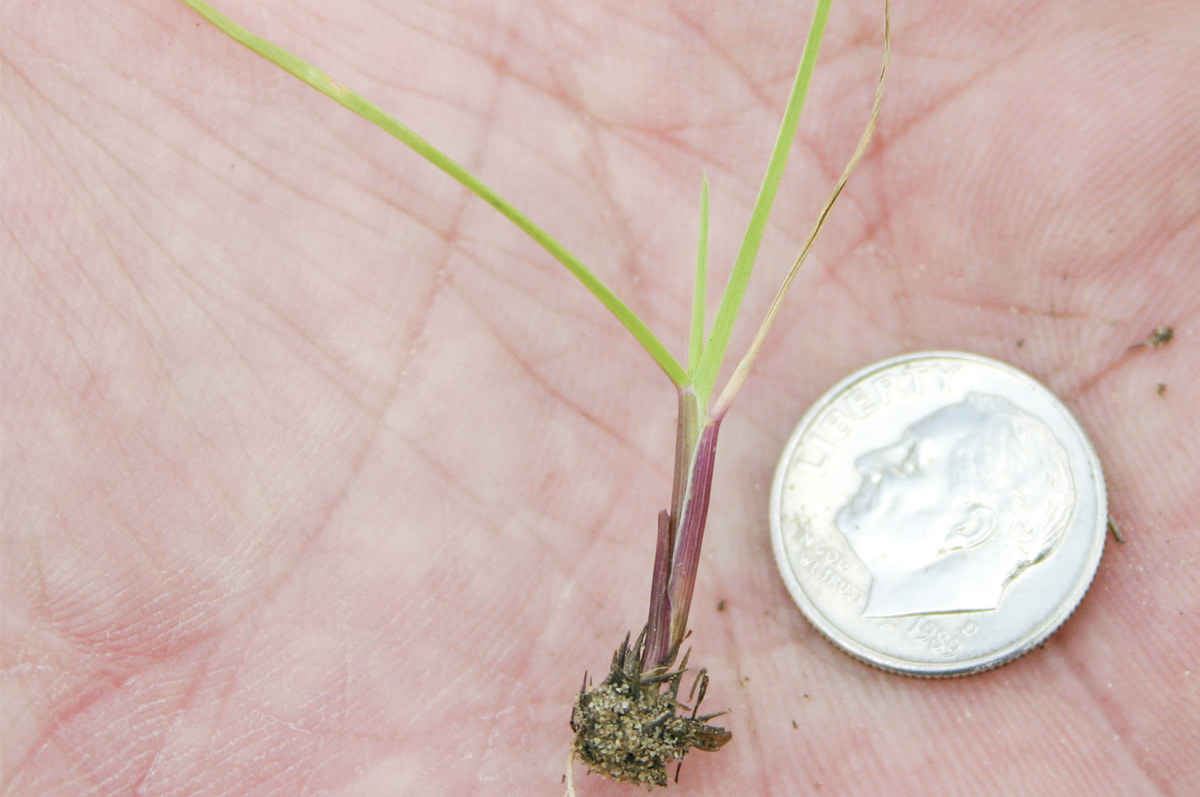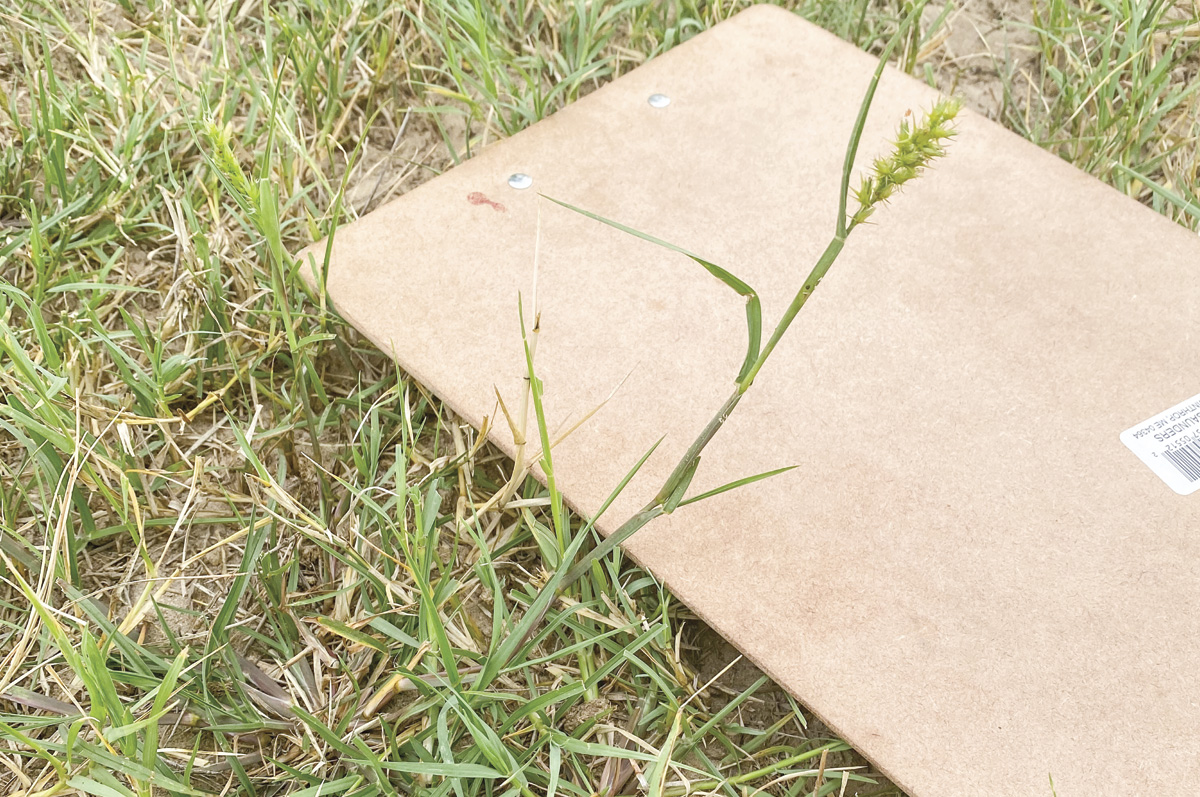Several species of sandbur infest the southern Great Plains of the U.S., including field sandbur (Cenchrus spandex Cav.), longspine sandbur (Cenchrus longispinis Hackel fern.) and southern sandbur (Cenchrus echinatus L.). While they are different species, they all share the common trait of being undesirable in pastures and hayfields, and control measures are the same for each species.
We often think of the sandbur species as being a warm-season annual plant. However, many of these are classified as perennials, which can survive from one year to the next. Although foliage may get burned off by freezing temperatures in the fall or winter, often these plants survive and come back from the roots the following spring. These plants are more difficult to eradicate, as they have already developed a substantial root system the previous year. Whenever you have a weak stand of annual or perennial grass forage, sandburs will take advantage of this situation and flourish. Therefore, one of the best cultural control measures is to keep your forage grass stands healthy with proper management.
Seed germination starts when soil temperatures reach 52ºF and peaks at 75ºF. They can grow as tall as 2 feet. Leaf blades are smooth, twisted and 2 to 5 inches long. Ligules have a fringe of hairs. The leaf sheath is loose from the stem, smooth, flattened and slightly hairy on the margins. Flowers are a raceme of burs, the spikelets are two-flowered with one to three spikelets per bur. Plants reproduce from seeds, which are contained in the bur. The bur is covered with stiff, sharp spines and is painful when contacted. Burs generally overwinter on or near the soil surface. Seeds can remain dormant in the soil for many years. They can emerge throughout the spring and summer, and a flush of sandbur can often occur after a rain in late summer or fall. This complicates control techniques, as a new crop of sandbur can emerge after control measures have been applied. Emergence can occur until late fall if soil moisture and temperatures are adequate when viable seeds are present.
 A 2-inch sandbur is held in a palm that is around 5-by-5 inches. Photo provided by Vanessa Corriher-Olson.
A 2-inch sandbur is held in a palm that is around 5-by-5 inches. Photo provided by Vanessa Corriher-Olson.
Unfortunately, the easiest way to identify sandbur is by looking at its inflorescence after flowering, which is a terminal spike 1 to 3 inches long containing six to 20 spiny burs. What you may interpret as the seed is a seed “capsule” that usually contains from one to three seeds. This capsule provides a nice environment for the seed, soaking up soil moisture and holding it until the seed has been provided the other stimulants – warm temperatures, light, day length, etc. – necessary for germination. This is also what makes it more survivable than some other grass species in sandy soils that are more prone to dry out. For effective control, sandbur must be identified and managed early in the vegetative stage to avoid seed production. During the vegetative stage, the best way to identify sandbur is by looking at the leaf collar, which is the bond between the leaf blade and sheath. The sandbur collar is light-colored, hairy and contains a membrane – i.e., ligule – that has a fringe of hair.
Although young plants are often utilized as a grazing forage, this plant produces seed capsules that can perpetuate the population when in the advanced stages of seed production. More importantly, it has a very negative effect on hay quality and substantially reduces forage value.
There are two approaches to controlling sandbur with herbicides. One is to use a preemergent herbicide. Two products are now available. Prowl H2O and other formulations of pendimethalin can be applied preemergence to sandbur on dormant bermudagrass at rates from 1.1 to 4.2 quarts per acre. Good results can be obtained from pendimethalin if it is properly incorporated by at least 0.5 to 0.75 inches of rainfall or irrigation within seven days of application. Rezilon, the newest preemergent herbicide in forage production, can also be applied preemergence to sandbur on established bermudagrass, bahiagrass and other warm-season perennials. Indaziflam, the active ingredient, has been demonstrated to provide excellent control of southern sandbur with no bermudagrass injury.
The second approach is to use one of three products that are labeled for postemergence control – meaning the product must be sprayed onto an emerged sandbur plant. One product is Pastora and it must be applied to small sandbur plants (1.5 inches tall or across) at rates of 1 to 1.5 oz per acre. It is only labeled for use on bermudagrass, so applying it on any other forage species is illegal and could cause severe injury. There are no grazing or haying restrictions associated with the use of Pastora. There is a maximum use rate of 2.5 oz per acre within a 12-month period.
 The easiest way to identify sandbur is after flowering and then looking at its inflorescence, which is a terminal spike 1 to 3 inches long containing six to 20 spiny burs. Photo provided by Vanessa Corriher-Olson.
The easiest way to identify sandbur is after flowering and then looking at its inflorescence, which is a terminal spike 1 to 3 inches long containing six to 20 spiny burs. Photo provided by Vanessa Corriher-Olson.
Another postemergence treatment is Roundup PowerMax, which is labeled for use on bermudagrass hayfields immediately after the first hay cutting at a rate of 11 ounces per acre. This application will control many annual grasses other than sandbur. Some stunting or discoloration may occur if a broadcast application is made when plants are not dormant. Higher application rates may be used for hard-to-control weeds; however, higher rates will cause stand reduction in forages. It is important to treat as soon as possible after the first hay cutting for two reasons. First, there will be less crop injury since there will be less bermudagrass leaf area to take up herbicide. Second, the product must contact the sandbur plants while they are small and vegetative. A maximum of 2 quarts per acre per year can be applied with no grazing restrictions.
The third postemergence product should be used with caution. The active ingredient, imazapic, sold under the trade names such as Plateau and Impose, will stunt bermudagrass growth for at least 30 days. Some varieties, such as Jiggs and World Feeder, are more prone to injury than others. It is labeled for use in most perennial grass species, including native range. It is an excellent herbicide, with both preemergent and postemergence activity, but it is only recommended where controlling sandbur is more important than forage growth. It is relatively inexpensive and has a wide weed control spectrum. There are no grazing restrictions, but a seven-day hay harvest restriction applies when using imazapic. Unfortunately for bahiagrass growers, there are no selective herbicides available for postemergence control of sandburs. Strict adherence to label directions is required by law. Paying close attention to label directions will also ensure safe, effective and economical use. Herbicide labels contain directions for the proper rate and timing of application, a list of susceptible species, and information regarding cleanup and disposal following use.
The presence of sandburs can be an indication of a weak stand of forage. Sandburs are more tolerant of acidic, low-fertility soils than many of our warm-season forages. Sandburs effectively compete with more desirable forage species for sunlight, moisture and soil nutrients. One of the best cultural control measures is to maintain a healthy stand of forage with proper management.











